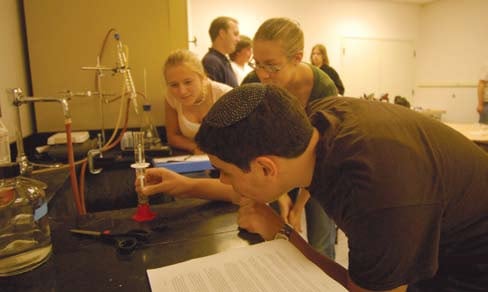
Terry Neimeyer warns that waning national interest in the engineering profession has reached cri- sis proportions. With the Baby Boomer generation set to retire, and their replacements in exceedingly short supply, a level of anxiety has crept in for employers like Neimeyer, who is the CEO of kCI Technologies, a multidisciplinary engineering firm that has offices in 13 states.
“There’s a feeling of helplessness in some respects,” he says. “It’s become clear that we in the engineering profession have to do more to get students interested in engineering and the sciences.”
Neimeyer and others in his position see hope in Engineering Innovation, a unique pre-college program aimed at demystifying engineering and showing off its creative character.
The program, founded in 2006 and run by the Whiting School’s Center for Educational Outreach, allows rising high school juniors and seniors to enroll in What is Engineering?—a course originally designed for Hopkins undergrad- uates by Michael karweit, a research professor of chemical and biomolecular engineering.
The program’s participants spend four to five weeks at Johns Hopkins or a partner institution (a college, high school, or learning academy) in the summer learning the basics of engineering as they conduct hands-on laboratory experiments and complete assignments that range from assembling a digital circuit that operates a robot to constructing a bridge made out of spaghetti and epoxy. The course, taught by college-level instructors trained by Johns Hopkins, is designed to illustrate how engineers think and problem solve.
Students who complete the program with a “B” or better are eligible to receive three transferable (elective college) credits from Johns Hopkins.
This summer, the Whiting School offered the program at 14 locations: four in Maryland, one in New Mexico, one in Pennsylvania, and eight sites in California (four within the University of California system).
The program has attracted an impressive list of private and public donors, including corporations such as Bechtel, Black & Decker, Pool and kent, TIME Center, and Whiting-Turner Contracting. The sponsors have allowed Johns Hopkins to expand the program, originally offered just in Maryland, and offer need-based financial aid for partial and full scholarships. Last year, nearly 80 percent of those enrolled received some tuition assistance.
This past year, due to increased sponsor support, Engineering Innovation was able to enhance its offerings by launching the New Mexico site and creating a monthlong Homewood residential program that offers a more immersive experience.
Neimeyer is buoyed by the program’s potential, especially in reaching students from disad- vantaged backgrounds, which was until now a largely untapped demographic.
“The hope is that [the high school students] who go through the program, get and stay inter- ested in the field,” he says, “and one day, maybe four to six years down the line, we’ll be able to recruit them as interns or employees.” — Terry Neimeyer
Marc Donohue, vice dean for research for the School of Engineering, says that most students enter the program with little to no knowledge of engineering. They are thrown into the deep end.
“This is a very challenging course in thinking. It’s more like boot camp than a summer camp,” says Donohue, adding that only half of participants earn a “B” or better.
Donohue concurs that the engineering pipe- line is shrinking at an alarming rate. According to national statistics, engineering school enrollments have declined nearly in half over the past 10 years. Part of the problem, Donohue says, is that students lose interest in math and science during their middle school years and it’s tough to win them back.
Engineering Innovation may offer one avenue for re-igniting student interest: A survey of the program’s alumni showed overwhelmingly positive responses.
And an optimistic Neimeyer is quick to note that “it’s a long shot, but one well worth trying.”




